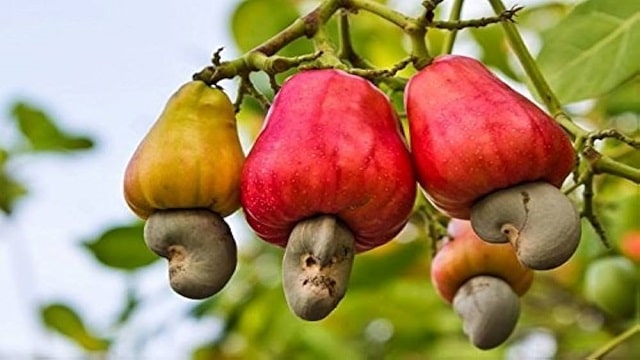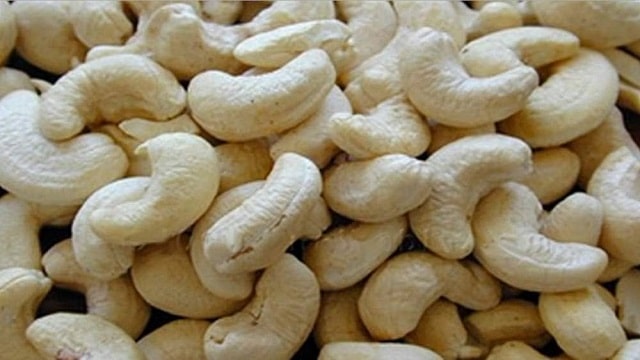Also known as cashews, cashew nuts, or cashew nuts, they are a low glycemic index and highly creamy nut from the tropics.
It is held by a fruit that is not a fruit. They are eaten raw, although not completely. And while some think it resembles a kidney, others think it beats. The cashew is a peculiar dried fruit. It came from the New World, spread throughout the tropics and its creaminess has ended up giving us vegan baking recipes. Here’s why a handful of cashews can be good for our health (as well as giving us endless curiosities).
What are cashews?
Cashews are the seed of the fruit of the cashew tree ( Anacardium occidentale ), a tree native to South America. Cashews are also known as cashew nuts, cashew nuts, or cashew nuts. They grow in humid tropical climates with temperatures between 20 and 30 °C at low altitudes and each cashew seed weighs about 5 g.
Cashew nuts grow in a very different way to other nuts. For example, walnuts grow protected by a hard shell and a fleshy covering, the fruit of the walnut tree. In contrast, in the cashew tree, what we discover is that the hard shell that surrounds the cashew is not inside the fleshy fruit, but hangs from it like a petiole or stem. The result is a fruit, not a pseudofruit, that looks more like a red pepper, which reminds some people of the shape of a kidney and others, like the French naturalist André Thevet, of an inverted heart, which is why he named it “Anacardium“, ” cardium” meaning heart and ” ana” meaning upwards.
Origin and history of cashews
The cashew ( Anacardium occidentale ) is native to Brazil, although it is cultivated throughout the world in tropical regions. The Spanish did not discover its existence until 1558 when they did not pay much attention to it because they believed it was inedible. Later, guided by the native Tupi, they discovered that the seed, after a roasting process, could be eaten without problems.
The Portuguese did the rest, bringing cashews with them on their journey between Europe, Africa, and Goa, the main trading port in southern India. Since then, cashew cultivation has continued to grow in the Asian country and its popularity has continued to increase on the other continents. Such has been the journey of the cashew that today its largest exporter is Africa, specifically Nigeria, South Africa, and Madagascar, and its largest importer is Europe.
Types of cashews
The cashew nut that reaches our table is more or less ivory, while its fruit (pseudo-fruit) varies between yellow and reddish hues. The difference in the color of the fruit is directly related to its benefits and culinary uses.
Common cashew
We are referring to the common cashew when we talk about pseudo-cashew fruits, also known as cashew apples, which are light in color and ripen in less than 6 days. In Latin America, it is commonly used to prepare juices or to add them to a banana smoothie, like any other fruit.
Red cashew

When we talk about red cashews, we are referring to the cashew apple with a carmine hue. The color is a direct result of ripening when it reaches or exceeds 6 days. At that time, it has higher amounts of anthocyanins, carotenes, and vitamin C. The only drawback is that the flavor can be very intense and the texture too tender.
Nutritional value of cashews
Rich in energy, protein, and minerals, cashews are also a good source of antioxidants and polyunsaturated fats that help take care of our cardiovascular health. They are notable for their selenium content and their more than 85% RDI of magnesium and 60% RDI of zinc. In 100 g of cashews, we find:
- Energy: 578 kcal
- Carbohydrates: 32 g
- Of which sugars: 6.4 g
- Fats: 42.2 g
- Proteins: 17.50 g
- Fiber: 2.9 g
- Magnesium: 267 mg
- Phosphorus: 373 mg
- Selenium: 24 mcg
- Zinc: 4.8 mg
- Vitamin E: 5.8 mg
Properties and benefits of cashews
Many people are concerned about the calories and sugars in nuts, but the truth is that the fiber and low glycemic index do a lot for our health. Cashews help lower cholesterol, do not raise blood sugar, and are rich in minerals that take care of bones and muscles.
Keeps the glycemic index low
Choosing the right foods when you have type II diabetes is easier when you know the glycemic index. This value reflects how quickly the sugar from food is released into our blood. The slower it happens, the less it unbalances our metabolism, the less insulin it requires to be processed, and the more recommended it is for cases of diabetes.
A low glycemic index is considered to be anything below 55. Cashews have a glycemic index of 25, and are also rich in fiber, making them an acceptable food for type II diabetes.
Good for cholesterol
The polyunsaturated fatty acid content represents more than 50% of the total fat in cashews. This type of fatty acid helps to lower LDL cholesterol and increase HDL cholesterol. As we know, the result is a lower risk of suffering from cardiovascular diseases in the future.
Recommended for a good mood
Cashews contain tryptophan, the precursor of serotonin. Serotonin is a neurotransmitter that regulates our mood and when found in low doses it causes states of despondency and even leads to clinical depression. Ensuring a good dose of tryptophan is a great idea to help in the synthesis of serotonin and maintain a good mood.
Maintain healthy muscles and bones
Along with sodium and potassium, magnesium is one of the most important minerals for the proper functioning of our body. It regulates multiple physiological reactions, allows our muscles to contract and relax, and takes care of our heartbeat. Cashews contain 83% of the daily recommended magnesium. Meanwhile, the 50% phosphorus present in cashews is essential for maintaining strong bones and teeth.
Antioxidants and immune system protectors
Cashews contain 40% selenium and 38% vitamin E of the RDA, so they have a great antioxidant capacity. Specifically, selenium not only protects us from free radicals but also repairs the damage caused by them and contributes to keeping our immune system healthy. Meanwhile, zinc, with 60% of the RDA, is responsible for healing our wounds.
Great source of minerals
Cashews contain mainly magnesium and phosphorus, selenium, and zinc. However, and especially due to their discrete presence among plant foods, it is worth highlighting their contribution of 15% iron together with 17% folic acid, values of great interest in vegetarian diets.
Regarding copper, there are many mentions on the Internet about its content in cashews. The truth is that the part of the cashew that contains the most copper and has been well studied so far, is the pulp, the fruit that accompanies the seed and not the seed itself. Of course, this fact is an invitation to drink cashew juice in the Caribbean where it is a widespread option, obtaining benefits from copper such as regulating the nervous system or supporting the metabolism, although unfortunately, we cannot expect the same benefits in a handful of cashew nuts.
Contraindications of cashews
Cashews as a dried fruit are contraindicated for children under 3 years of age due to the risk of choking. In addition, they could cause cross-allergy in patients who are allergic to them.
Allergies
Allergy to nuts such as cashews is identified by skin rashes, hives, and in more severe cases breathing difficulties and anaphylactic shock. Although it is not one of the most reactive nuts, it is important to pay attention to possible symptoms.
Be careful with mangoes and pistachios
Mangos, pistachios, and cashews belong to the same botanical family Anacardiaceae. This means that cross-reactivity can occur and therefore, people with cashew allergies may also respond with the same symptoms to mangos and pistachios. For this reason, it is important to take special care when consuming any of the three.
Are cashews toxic?
No, but its shell could be. As a protective measure, the hard shell of the cashew nut contains urushiol, a toxic skin irritant that can permeate the cashew nut. To avoid risks, cashews are always steamed or roasted before they reach the consumer, to avoid potential risks.
Recipes with cashews and their uses in cooking
It took us a long time to discover the benefits of a delicious and smooth cashew cream. Spread on some sourdough bread toast, it requires nothing more than a good coffee to make an unforgettable breakfast.
We are more familiar with finding cashews as the crowning glory of a red curry or pumpkin noodles at an Asian restaurant. And I wish it was a daily occurrence for us to add cashews to homemade granola or energy bars for the fresh crunch they add. Or if we are going to discover them, we might have the opportunity to add them to our next version of vegan cheesecake.
How many cashews can you eat per day?
We can eat 30 g of cashews a day, as long as it is not contraindicated for us. As a snack or snack, it is ideal due to its minerals, fiber, and protein, which also keep us feeling full for longer.
Now, just as we saw in the case of almonds or walnuts, cashews provide a lot of energy, up to 580 kcal per 100 g, so they should always be taken in the right amount. One recommendation is to prepare our own mix of natural, unsalted nuts, ensuring that in each daily handful, we take all kinds of minerals and vitamins.
Which are healthier, cashews or almonds?
Almonds are healthier than cashews. Almonds contain more vitamin E and phosphorus. They also have very similar levels to cashews in other minerals such as magnesium, calcium zinc, and fiber. On the other hand, almonds contain less carbohydrates, which makes them especially recommended in Western diets.
